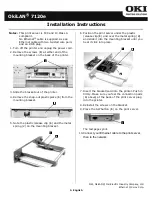
Issue 2.0
5-12
Network Design Considerations
5.2 Bandwidth
The bandwidth required for VoIP calls depends on several factors, including:
Number of simultaneous calls
CODEC used
Frame Size
Data Networking Protocol used
UNIVERGE SV9100 CCIS Network parameters
The more frames encapsulated into each packet, the less bandwidth is required.
This is because each packet transmitted has the same header size. Therefore, if
numerous very small packets are sent then bandwidth is also being used for a
large amount of header information. If we add several frames to the packet, less
packets are transmitted and therefore have less header information sent.
If we add many voice frames to each packet, less bandwidth is being used.
However, this does have disadvantages. If there is a large packet size, and a
particular voice packet is lost, this has a greater impact on the speech quality. If a
small quantity of voice frames per packet is being used, the effect of losing a
packet is reduced.
As a general rule: The more frames per packet, the less bandwidth is used, but
the quality is also lower.
Examples:
Example 1: CODEC: G.729 Frame Size: 10ms Voice Frames per Packet: 2 Voice
Sample Size: 20ms (frame size x Voice Frames) Bandwidth Required: 24Kbps
Example 2: CODEC: G.729 Frame Size: 80ms Voice Frames per Packet: 8 Voice
Sample Size: 80ms (frame size x Voice Frames) Bandwidth Required: 12Kbps
Summary of Contents for Univerge SV9100
Page 1: ...Networking Manual A50 035910 004 AU Issue 2 0...
Page 20: ...xviii Table of Contents Issue 2 0...
Page 26: ...xxiv List of Figures Issue 2 0...
Page 33: ...Book 1 SV9100 K CCIS...
Page 49: ...Issue 2 0 1 16 General Information US Only Figure 1 15 Circuit Identification Codes CIC...
Page 53: ...Issue 2 0 1 20 General Information US Only...
Page 61: ...Issue 2 0 2 8 Hardware Installation US Only...
Page 195: ...Issue 2 0 4 116 Features and Specifications...
Page 242: ...Book 2 SV9100 IP Networking...
Page 256: ...Issue 2 0 2 12 IP Networking...
Page 312: ...Issue 2 0 4 48 Programming...
Page 376: ...Issue 2 0 6 30 SIP Trunking...
Page 391: ...Issue 2 0 7 14 H 323 Trunking...
Page 467: ...Issue 2 0 8 76 IP Multiline Station SIP...
Page 551: ...Issue 2 0 10 64 SV9100 NetLink Conditions None Feature Cross Reference None...
Page 567: ...Issue 2 0 10 80 SV9100 NetLink Conditions None Feature Cross Reference None...
Page 579: ...Issue 2 0 11 6 NAPT...
Page 580: ...Issue 2 0 SV9100 Networking Manual 11 7...
Page 581: ...Issue 2 0 11 8 NAPT...
Page 582: ...Issue 2 0 SV9100 Networking Manual 11 9...
Page 583: ...Issue 2 0 11 10 NAPT...
Page 584: ...Issue 2 0 SV9100 Networking Manual 11 11...
Page 595: ...Issue 2 0 12 4 All DSP Busy Indication...
Page 671: ...Issue 2 0 13 76 AspireNet Conditions None Feature Cross Reference None...
Page 685: ...Issue 2 0 13 90 AspireNet Department Calling Flexible System Numbering Intercom...
Page 707: ...Issue 2 0 13 112 AspireNet Default Trunk Port Number Name 1 Line 001 2 Line 002 400 Line 400...
Page 713: ...Issue 2 0 13 118 AspireNet Department Calling...
Page 765: ...Issue 2 0 13 170 AspireNet...
















































